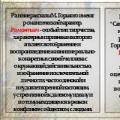Energy of the electrostatic field." Presentation on physics on the topic "Capacitor. "Electrostatic field energy" Tips on how to make a good presentation or project report
1 option
- The electrical capacitance of two conductors is called...
- Polarization of dielectrics is called...
- The unit of electrical capacity is expressed in...
Option 2
- Surfaces of equal potential are called...
- The electrostatic field potential is called...
- The unit of electric field strength is expressed in...
Slide 2
Physical dictation.
- 1 option
The electrical capacitance of two conductors is the ratio of the charge of one of the conductors to the potential difference between this conductor and the neighboring one.
Polarization of dielectrics is the displacement of positive and negative bound charges in opposite directions.
The unit of electrical capacity is expressed in farads (F).
- Option 2
Surfaces of equal potential are called equipotential.
The electrostatic field potential is the ratio of the potential energy of a charge in the field to this charge.
The unit of electric field strength is expressed in volts per meter (V/m) or newtons per coulomb (N/C).
Slide 3
3.04.07
Slide 4
Lesson objectives:
- Learn to determine the energy of a charged capacitor.
- Develop the ability to apply physical laws when solving problems.
- Find out the practical significance of the capacitor.
Slide 5
Capacitors.
A capacitor consists of two conductors separated by a dielectric layer, the thickness of which is small compared to the size of the conductors.
The electrical capacity of a flat capacitor is determined by the formula:
Slide 6
Energy of a charged capacitor.
E - q + q
The energy of a capacitor for the potential energy of a charge in a uniform field is equal to:
Slide 7
Application of capacitors
Types of capacitors:
Air,
Paper,
Mica,
Electrostatic.
Purpose:
- Accumulate charge or energy for a short time to quickly change potential.
- Do not pass direct current.
- In radio engineering - an oscillatory circuit, a rectifier.
- Application in photographic equipment.
Slide 8
Consolidation.
Theoretical material on:
- What are capacitors used for?
- How does a capacitor work?
- Why is the space between the capacitor plates filled with dielectrics?
- What is the energy of a charged capacitor?
Slide 9
Problem solving:
1. What is the capacitance of the capacitor? If he received a charge of 6. 10-5 C, from a 120 V source.


The simplest flat capacitor consists of two identical parallel plates (called plates), located at a small distance from each other and separated by a dielectric layer. The plates are supplied with charges from the power source that are equal in magnitude but opposite in sign. Thus, a potential difference arises between the plates. The entire electric field is concentrated inside the capacitor and is uniform.


The main characteristic of a capacitor is electrical capacitance (electrical capacity), which is designated by the letter C. Electrical capacity is a physical quantity that characterizes the ability of two conductors to accumulate an electrical charge. The SI unit of electrical capacitance is named after the great scientist Michael Faraday and is called the farad. One farad is a very large value, so in practice they use μF, nF, pF.

The electrical capacity of two conductors is the ratio of the charge of the conductor to the potential difference between them. Electrical capacity does not depend either on the charge imparted to the conductors or on the potential difference that arises between them. The capacitance of a capacitor is determined by the geometric dimensions of the conductors, shape, location and, of course, the dielectric constant of the medium. The electrical capacity of two conductors is the ratio of the charge of the conductor to the potential difference between them. Electrical capacity does not depend either on the charge imparted to the conductors or on the potential difference that arises between them. The capacitance of a capacitor is determined by the geometric dimensions of the conductors, shape, location and, of course, the dielectric constant of the medium.

To charge a capacitor, work must be done to separate positive and negative charges. According to the law of conservation of energy, this work is equal to the energy of the capacitor. To charge the capacitor, you need to do work to separate positive and negative charges. According to the law of conservation of energy, this work is equal to the energy of the capacitor




Scope of application: 1) radio engineering and electrical engineering 1) radio engineering and electrical engineering 2) in photographic equipment, the well-known photoflash. 2) in photographic equipment everyone knows the flash. 3) in laser technology. 3) in laser technology. 4) in computer memory elements and your favorite computer. After all, under the covers of numbers and symbols on a computer keyboard there are capacitors. 4) in computer memory elements and your favorite computer. After all, under the covers of numbers and symbols on a computer keyboard there are capacitors. 5) the capacitor has found application in measuring the humidity of air and wood, 5) the capacitor has found application in measuring the humidity of air and wood, 6) in a short circuit protection system. 6) in the short circuit protection system.

Slide 1
Homework check: Physical dictation. Option 1 The electrical capacitance of two conductors is called... The polarization of dielectrics is called... The unit of electrical capacitance is expressed in... Option 2 The surface of equal potential is called... The electrostatic field potential is called... The unit of electric field strength is expressed in...Slide 2
 Homework check: Physical dictation. Option 1 The electrical capacity of two conductors is the ratio of the charge of one of the conductors to the potential difference between this conductor and the neighboring one. Polarization of dielectrics is the displacement of positive and negative bound charges in opposite directions. The unit of electrical capacity is expressed in farads (F). Option 2 Surfaces of equal potential are called equipotential. The electrostatic field potential is the ratio of the potential energy of a charge in the field to this charge. The unit of electric field strength is expressed in volts per meter (V/m) or newtons per coulomb (N/C).
Homework check: Physical dictation. Option 1 The electrical capacity of two conductors is the ratio of the charge of one of the conductors to the potential difference between this conductor and the neighboring one. Polarization of dielectrics is the displacement of positive and negative bound charges in opposite directions. The unit of electrical capacity is expressed in farads (F). Option 2 Surfaces of equal potential are called equipotential. The electrostatic field potential is the ratio of the potential energy of a charge in the field to this charge. The unit of electric field strength is expressed in volts per meter (V/m) or newtons per coulomb (N/C).
Slide 3

Slide 4
 Lesson objectives: Learn to determine the energy of a charged capacitor. Develop the ability to apply physical laws when solving problems. Find out the practical significance of the capacitor.
Lesson objectives: Learn to determine the energy of a charged capacitor. Develop the ability to apply physical laws when solving problems. Find out the practical significance of the capacitor.
Slide 5
 Capacitors. A capacitor consists of two conductors separated by a dielectric layer, the thickness of which is small compared to the size of the conductors. The electrical capacity of a flat capacitor is determined by the formula: q C = - U
Capacitors. A capacitor consists of two conductors separated by a dielectric layer, the thickness of which is small compared to the size of the conductors. The electrical capacity of a flat capacitor is determined by the formula: q C = - U
Slide 6
 Energy of a charged capacitor. - The energy of a capacitor for the potential energy of a charge in a uniform field is equal to: 1. W = + + + + + - - - - E - q + q 1 2 q E d 2. W = q U= CU 1 1 2 2 2 2 p p
Energy of a charged capacitor. - The energy of a capacitor for the potential energy of a charge in a uniform field is equal to: 1. W = + + + + + - - - - E - q + q 1 2 q E d 2. W = q U= CU 1 1 2 2 2 2 p p
Slide 7
 Application of capacitors Types of capacitors: - air, - paper, - mica, - electrostatic. Purpose: To accumulate charge or energy for a short time to quickly change the potential. Do not pass direct current. In radio engineering - an oscillatory circuit, a rectifier. Application in photographic equipment.
Application of capacitors Types of capacitors: - air, - paper, - mica, - electrostatic. Purpose: To accumulate charge or energy for a short time to quickly change the potential. Do not pass direct current. In radio engineering - an oscillatory circuit, a rectifier. Application in photographic equipment.
Slide 8
 Consolidation. Theoretical material on the questions: What are capacitors used for? How does a capacitor work? Why is the space between the capacitor plates filled with dielectrics? What is the energy of a charged capacitor?
Consolidation. Theoretical material on the questions: What are capacitors used for? How does a capacitor work? Why is the space between the capacitor plates filled with dielectrics? What is the energy of a charged capacitor?
Slide 9
 Consolidation. Solving problems: 1. What is the capacitance of the capacitor. If he received a charge of 6. 10-5 C, from a 120 V source.
Consolidation. Solving problems: 1. What is the capacitance of the capacitor. If he received a charge of 6. 10-5 C, from a 120 V source.
Slide 10
 Problem No. 1. Given: q = 6. 10-5 C U = 120 V C =? F Solution: C = q:U C = 6. 10-5: 120= 0.5 µF Answer: 0.5 µF.
Problem No. 1. Given: q = 6. 10-5 C U = 120 V C =? F Solution: C = q:U C = 6. 10-5: 120= 0.5 µF Answer: 0.5 µF.
Do you want to become better at computer skills?
Google services allow you to create an online survey with different types of answer options and automatically create a summary table with the answers of all respondents. Survey forms can be embedded on website pages, but you do not need to have your own website to conduct such a survey. The scope of such surveys is wide; teachers can conduct surveys of parents or school students by sending a link to the survey page by email, posting on social networks or on the school website. The survey can be either anonymous or only from authorized users. Let's consider creating your own online survey in Google services.
Read new articles
The national project “Digital Educational Environment” is coming to Russian regions: equipment will be supplied to schools and Internet access will be improved. But let's not forget about the content: what will the teacher do with new but empty computers? A digital classroom is not only computers and the Internet; an important component of the digital environment are tools and services that allow organizing the educational process at school using electronic educational resources.

Today we have an unusual lesson. We have guests. Let's say hello to them. Please sit down.
Each of you has a working lesson map on the table. Sign your name on it. After completing each task, you will enter the number of points for completing the task. At the end of the lesson, we will calculate the total number of points and assign an appropriate grade.
Checking the studied material.
Physical dictation.
(after completion - mutual verification).
Option 1.
1). A conductor is a substance in which... (free charges can move throughout the entire volume).
2). Semiconductors include...(minerals, oxides, sulfides, germanium, silicon, selenium, fat, brine, blood, carbon).
3). The electrical capacity of a solitary conductor is calculated using the formula....(C = Q/φ).
4) ε 0 is ... (electric constant and equal to 8.85 * 10 -12 C 2 / N * m 2).
5) Electrical capacity is measured in... (farads).
6) The electrical capacity of a sphere depends...(on the radius).
7) What three groups are all substances divided into... (conductor, semiconductor, dielectric).
Option 2.
1) A semiconductor is a substance in which... (the number of free charges depends on external conditions).
2) Conductors include... (metals. Solutions of salts, alkalis, acids, moist air, plasma, human body).
3) The electrical capacity of a solitary ball is calculated using the formula...(C = 4π ε 0 ε R).
4) ε is...(dielectric constant of the medium)
5) Charge is measured in... (coulombs).
6) The electrical capacity of a sphere does not depend on... (the charge on its surface).
7) Dielectrics include... (gases, distilled water, benzene, oils, glass, porcelain, mica, wood and others).
Learning new material.
(during the review, a supporting summary is filled out).
To store electrical charges, a device called a capacitor is used.
What is a capacitor? What does it consist of?
Basic summary.
A capacitor is... (a system of two conductors separated by a dielectric layer, the thickness of which is small compared to the size of the conductor).
Conductors are...(capacitor plates).
Capable of accumulating a large charge.
Symbol:
Electric field inside a capacitor.
In order to charge….(connect its plates to the poles of the current source).
Types of capacitors: air, mica, ceramic, paper, electrolytic,…
(table display: Types of capacitors).
Message: first capacitor.
The main characteristic is electrical capacity.
Electrical capacity is..(a physical quantity characterizing the ability of two conductors to accumulate an electrical charge).
Showing an animation on the computer: “Capacitance of a capacitor and its use.”
C =q /φ; C = εε 0 S / d.
Unit of measurement: Farad (F).
Application:
radio engineering;
camera flash;
computer keyboard;
Capacitor energy.
(Animation: “Capacitor Design and Energy”).
Types of connections in the diagram:
C = C 1 + C 2 +……..
1 / C = 1 / C 1 + 1 / C 2 +….
Flaws:
Energy does not last long.
Discharges quickly.
Requires constant recharging.
Problem solving.
The capacitor has an electrical capacity C = 5pF. What charge was on each of its plates if the potential difference between them is U = 100 V.
Charge q = 6 * 10 -4 C on the plates of a flat capacitor creates a potential difference between the plates of 200 V. Determine the electrical capacity of the capacitor. (Kasyanov: Physics -10, p. 403, task No. 1).
Calculate the energy of the electrostatic field of a capacitor with a capacity of 0.1 μF, charged to a potential difference of 200V. (Kasyanov: Physics - 10, p. 406, task No. 1).
Find the electrical capacity of a flat capacitor if the area of each plate is 1 m 2, the distance between the plates is 1.5 mm. The dielectric is mica (ε = 6).
Independent work.
(after completion they check with each other)
Option 1.
1. What is the capacitance of the capacitor if, when charging it to a voltage of 1.4 kV, it receives a charge of 28 nC?
2. Calculate the energy of the starting motor capacitor at the moment of its complete discharge, if it is known that the voltage on the plates is 300 V and the capacitance of the capacitor is 0.25 μF.
Option 2.
1. Find the capacity of an air capacitor charged to a potential difference of 200 V. The area of each plate is 0.25 m2, the distance between them is 1 mm. (ε = 1).
2. The capacitor says 4 µF, 100 V. What is the maximum energy it can have.
Summing up the lesson. Grading.
What new did you learn? What have you learned?
Review basic concepts (capacitor, plates, capacity, energy, application).
Homework.
Learn the supporting notes.
Solve a problem.
Task: The area of each plate of a flat-plate capacitor is 200 cm 2 , and the distance between them is 1 cm. What is the field energy if the field strength is 500 kV/m?
 Gorky "Old Woman Izergil"
Gorky "Old Woman Izergil" Main directions for improving working conditions Improvement of employee qualifications
Main directions for improving working conditions Improvement of employee qualifications Customs business: specialty profile in Russian universities Admission to university customs by correspondence
Customs business: specialty profile in Russian universities Admission to university customs by correspondence